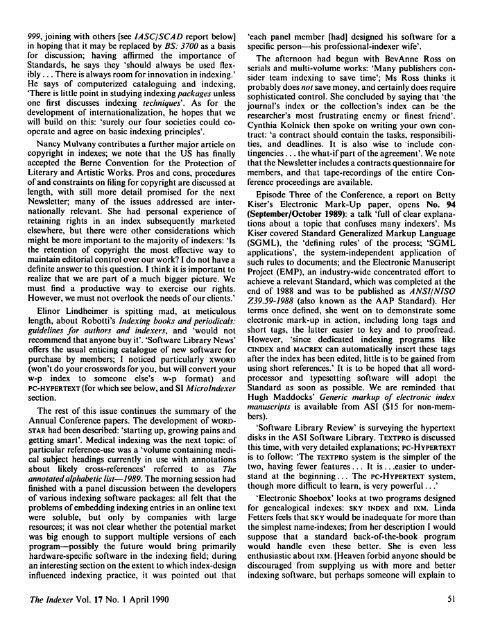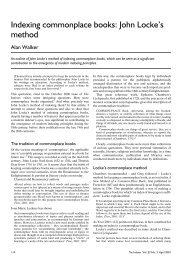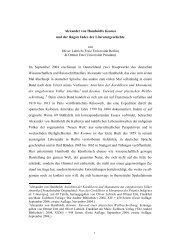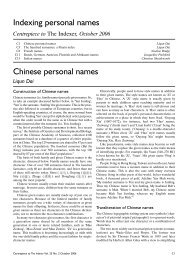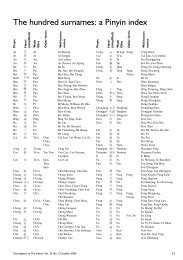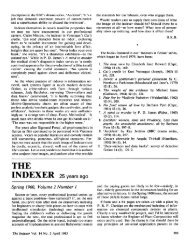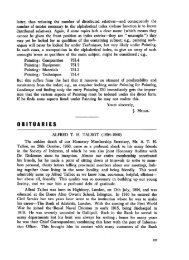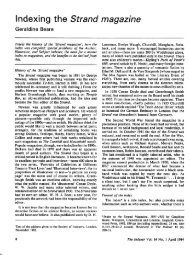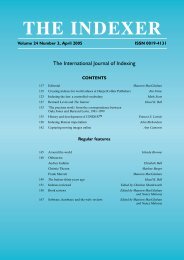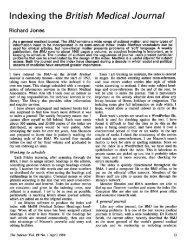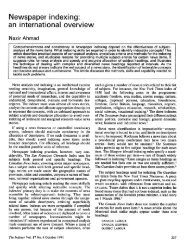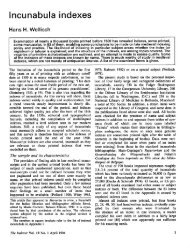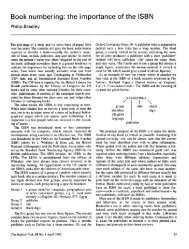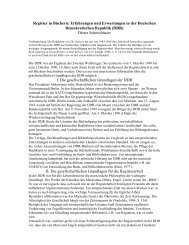SHOEBOX, INTERNATIONAL:
SHOEBOX, INTERNATIONAL:
SHOEBOX, INTERNATIONAL:
You also want an ePaper? Increase the reach of your titles
YUMPU automatically turns print PDFs into web optimized ePapers that Google loves.
999, joining with others [see IASC/SCAD report below]<br />
in hoping that it may be replaced by BS: 3700 as a basis<br />
for discussion; having affirmed the importance of<br />
Standards, he says they 'should always be used flex<br />
ibly ... There is always room for innovation in indexing.1<br />
He says of computerized cataloguing and indexing,<br />
'There is little point in studying indexing packages unless<br />
one first discusses indexing techniques'. As for the<br />
development of internationalization, he hopes that we<br />
will build on this: 'surely our four societies could co<br />
operate and agree on basic indexing principles'.<br />
Nancy Mulvany contributes a further major article on<br />
copyright in indexes; we note that the US has finally<br />
accepted the Berne Convention for the Protection of<br />
Literary and Artistic Works. Pros and cons, procedures<br />
of and constraints on filing for copyright are discussed at<br />
length, with still more detail promised for the next<br />
Newsletter; many of the issues addressed are inter<br />
nationally relevant. She had personal experience of<br />
retaining rights in an index subsequently marketed<br />
elsewhere, but there were other considerations which<br />
might be more important to the majority of indexers: 'Is<br />
the retention of copyright the most effective way to<br />
maintain editorial control over our work? I do not have a<br />
definite answer to this question. I think it is important to<br />
realize that we are part of a much bigger picture. We<br />
must find a productive way to exercise our rights.<br />
However, we must not overlook the needs of our clients.'<br />
Elinor Lindheimer is spitting mad, at meticulous<br />
length, about Robotti's Indexing books and periodicals:<br />
guidelines for authors and indexers, and 'would not<br />
recommend that anyone buy it1. 'Software Library News'<br />
offers the usual enticing catalogue of new software for<br />
purchase by members; I noticed particularly xword<br />
(won't do your crosswords for you, but will convert your<br />
w-p index to someone else's w-p format) and<br />
pc-hypertext (for which see below, and SI Microlndexer<br />
section.<br />
The rest of this issue continues the summary of the<br />
Annual Conference papers. The development of wordstar<br />
had been described: 'starting up, growing pains and<br />
getting smart'. Medical indexing was the next topic: of<br />
particular reference-use was a 'volume containing medi<br />
cal subject headings currently in use with annotations<br />
about likely cross-references' referred to as The<br />
annotated alphabetic list—1989. The morning session had<br />
finished with a panel discussion between the developers<br />
of various indexing software packages: all felt that the<br />
problems of embedding indexing entries in an online text<br />
were soluble, but only by companies with large<br />
resources; it was not clear whether the potential market<br />
was big enough to support multiple versions of each<br />
program—possibly the future would bring primarily<br />
hardware-specific software in the indexing field; during<br />
an interesting section on the extent to which index-design<br />
influenced indexing practice, it was pointed out that<br />
'each panel member [had] designed his software for a<br />
specific person—his profcssional-indexer wife'.<br />
The afternoon had begun with BevAnne Ross on<br />
serials and multi-volume works: 'Many publishers con<br />
sider team indexing to save time'; Ms Ross thinks it<br />
probably does not save money, and certainly does require<br />
sophisticated control. She concluded by saying that 'the<br />
journal's index or the collection's index can be the<br />
researcher's most frustrating enemy or finest friend'.<br />
Cynthia Kolnick then spoke on writing your own con<br />
tract: 'a contract should contain the tasks, responsibili<br />
ties, and deadlines. It is also wise to include con<br />
tingencies ... the what-if part of the agreement'. We note<br />
that the Newsletter includes a contracts questionnaire for<br />
members, and that tape-recordings of the entire Con<br />
ference proceedings are available.<br />
Episode Three of the Conference, a report on Betty<br />
Riser's Electronic Mark-Up paper, opens No. 94<br />
(September/October 1989): a talk 'full of clear explana<br />
tions about a topic that confuses many indexers'. Ms<br />
Riser covered Standard Generalized Markup Language<br />
(SGML), the 'defining rules' of the process; 'SGML<br />
applications', the system-independent application of<br />
such rules to documents; and the Electronic Manuscript<br />
Project (EMP), an industry-wide concentrated effort to<br />
achieve a relevant Standard, which was completed at the<br />
end of 1988 and was to be published as ANSI/NISO<br />
Z39.59-1988 (also known as the AAP Standard). Her<br />
terms once defined, she went on to demonstrate some<br />
electronic mark-up in action, including long tags and<br />
short tags, the latter easier to key and to proofread.<br />
However, 'since dedicated indexing programs like<br />
cindex and macrex can automatically insert these tags<br />
after the index has been edited, little is to be gained from<br />
using short references.' It is to be hoped that all wordprocessor<br />
and typesetting software will adopt the<br />
Standard as soon as possible. We are reminded that<br />
Hugh Maddocks' Generic markup of electronic index<br />
manuscripts is available from ASI ($15 for non-mem<br />
bers).<br />
'Software Library Review' is surveying the hypertext<br />
disks in the ASI Software Library. Textpro is discussed<br />
this time, with very detailed explanations; pc-Hypertext<br />
is to follow: 'The textpro system is the simpler of the<br />
two, having fewer features... It is.. .easier to under<br />
stand at the beginning... The pc-Hypertext system,<br />
though more difficult to learn, is very powerful...'<br />
'Electronic Shoebox' looks at two programs designed<br />
for genealogical indexes: sky index and ixm. Linda<br />
Fetters feels that sky would be inadequate for more than<br />
the simplest name-indexes; from her description I would<br />
suppose that a standard back-of-the-book program<br />
would handle even these better. She is even less<br />
enthusiastic about ixm. [Heaven forbid anyone should be<br />
discouraged from supplying us with more and better<br />
indexing software, but perhaps someone will explain to<br />
The Indexer Vol. 17 No. 1 April 1990 51


